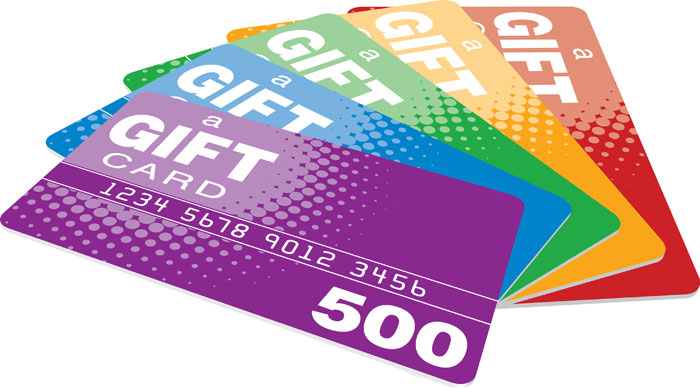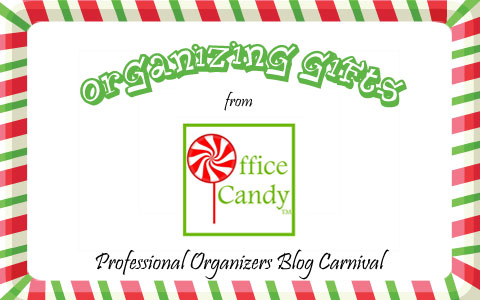4 Surprising Ways Gift Cards Can Increase Margins for Professional Organizers
This page may contain links to Amazon.com or other sites from which I may receive commission on purchases you make after clicking on such links. Read my full Disclosure Policy

It’s been more than 5 years since Janet Barclay wrote The Pros and Cons of Offering Gift Certificates for Organizing Services which covered some of the ethical and business considerations associated with offering gift cards as a professional organizer. That article, which is still relevant today, generated a lengthy discussion in the comments section about some of the downsides of accepting gift cards. Specifically, that as the professional organizer you often don’t have the opportunity to meet with the end-user client prior to agreeing to service when selling a gift card, meaning that in some cases either the end-user is not an ideal client, or they’re not as motivated as a first party user. Those concerns are all legitimate issues that should be considered, and as they’re not directly addressed in this article, I’d encourage you to read that article before deciding whether gift cards are right for your business.
Assuming that you are comfortable offering gift cards as a general matter for your professional organizing business, this article will make the business and financial case that doing so is a worthwhile endeavor. Specifically, we’ll explain how gift cards drive higher margin purchases, they provide a reduced cost method of issuing credits or refunds, they can expand your clientele, and they contain a significant “hidden margin” in the form of breakage. So, without further ado, here are four surprising ways gift cards can increase margins for your professional organizing business.
1. Gift Cards Drive Larger and Higher-Margin Purchases
Small business owners often have the mistaken belief that gift card purchases limit or cap the amount that a customer will ultimately spend. That is, that a customer with a $100 gift card is going to try their darnedest to purchase $99.99 in services, but not a penny more. In truth, however, over 70% of gift card users spend more than the original amount of the gift card when redeeming. And of those individuals, 8% purchased a more expensive item or service than they’d originally intended to. Additionally, studies show that simply by changing the medium of payment from a credit card to a gift card results in a 15% to 35% increase in the total purchase amount.
Looking at the implications of those statistics a little more closely, that means that purchasers who pay via a gift card, in general, spend 15-35% more than they would have otherwise, and that much of that increase comes in the form of “upgrade” or premium products, which generally tend to be higher margin services.
2. A Better Credit Alternative for Disgruntled Customers
Not every professional organization consultation will turn out perfectly. In some cases, disgruntled customers may want a full refund and you may want to give them that refund in order to just close the relationship and go your separate ways. But in other situations, a customer may request merely a partial refund, or a temporary refund while the service is rescheduled, or in some situations additional services to compensate them. In those situations, issuing the customer a gift card can be a good means of resolving an otherwise uncomfortable situation at a significantly lower cost to you than a cash refund.
The benefits of using a gift card to resolve these types of situations are numerous. First, the cost of the “refund” or “discount” is only incurred when the gift card is redeemed, providing you with additional cashflow in the short term. After factoring in breakage, which effectively reduces the cost of that discount or refund by 30% (discussed further below), and given that when gift cards are redeemed they typically drive additional sales, particularly in higher margin goods, the cost to the actual business of a discount or refund provided in the form of a gift card may only be 50% of the sticker price of the gift card. And finally, issuing a refund or discount in the form of a gift card can provide you with a second opportunity to prove to the customer that their previous negative experience was anomalous, and better ensure that there is not a dissatisfied customer walking around who can potentially cause your business long-term reputational harm.
All combined, the benefits of providing a disgruntled customer with a discount or refund in the form of a gift card are substantial. And while there are certainly many situations in which simply providing a full refund in cash and walking away from the relationship make sense, in those situations where an ongoing relationship is of mutual interest, providing a discount or refund in the form of a gift card is not only significantly cheaper but has strategic business advantages as well.
3. Expanding Your Clientele
The experience of many of these commenters is consistent with studies of users of gift cards, which is that many of them weren’t aware of the company at all, and an even larger percentage would not have made a purchase without the additional push of having received a gift card.
In some situations, that can be a negative, insofar as a person purchasing professional organizing services for themselves typically have a greater understanding and commitment to fully participating in the process, as opposed to someone who received the service as a gift. But looked at another way, recipients of gift cards provide you with a unique opportunity to reach a clientele (with their own separate circle of friends and potential future referrals) that you wouldn’t have otherwise reached. Thus, even though a customer that comes to you via a gift card may be slightly more work on the front end, the future customers that can come from this new relationship may more than compensate for any additional hassle.
4. Gift Card Breakage
If you’ve ever wondered why when making a purchase at a store like Costco you received an “instant cash back gift card” when making a big purchase, as opposed to them just lowering the cost of the good, the reason is breakage. Breakage is the payment industry term for the percentage of gift cards which are never redeemed. The figure varies significantly by industry, but averaged across all industries about 30% of all gift cards are never redeemed, totaling $41 billion dollars in unredeemed gift cards since 2005. For small businesses with limited geographic scope, such as professional organizing businesses, the percentage of unredeemed gift cards may be even higher, approaching 50%. And while there are US federal regulations which require, for example, that gift cards cannot expire for 5 years, in general, if a gift card has not been redeemed within a year, it likely will never be redeemed. Consequently, those funds can largely be regarded as pure profit after a year. It’s important to note, that some states have escheatment laws which require a business after some time to add the value of an unused gift card to the state treasury’s general fund until it’s collected by its rightful owner. Most retailers, particularly small companies, however, have largely ignored this requirement to no consequence, and even to the extent it is applicable, at a minimum gift card breakage provides you with extended free cash flow.
In sum, analyzing gift cards purely from the financial perspective of a professional organizer, any professional organizing services which are purchased from you via a gift card, bring with that purchase an additional 30-50 percent margin over and above the profit margin from a client purchasing with cash or credit.
Conclusion
There are certainly legitimate reasons why a professional organizing business might choose not to offer gift cards. Specifically, the business owner may find the administrative hassle burdensome, the ethical dilemma of accepting payment for a service that might never be redeemed difficult to reconcile, or the fact that customers redeeming gift cards may not be ideal (or at a minimum not pre-vetted) clientele. It is difficult, however, to deny the financial and business appeal of offering gift cards, and at a 7% year over year growth rate, their presence in the market is only increasing. From providing free hidden profit margin, to resolving disputes in a lower cost way, to expanding your clientele outside of your existing circle of references, and finally to driving larger and higher-margin sales, gift cards can be a significant financial boon to professional organizers.
Image © almagami / depositphotos



